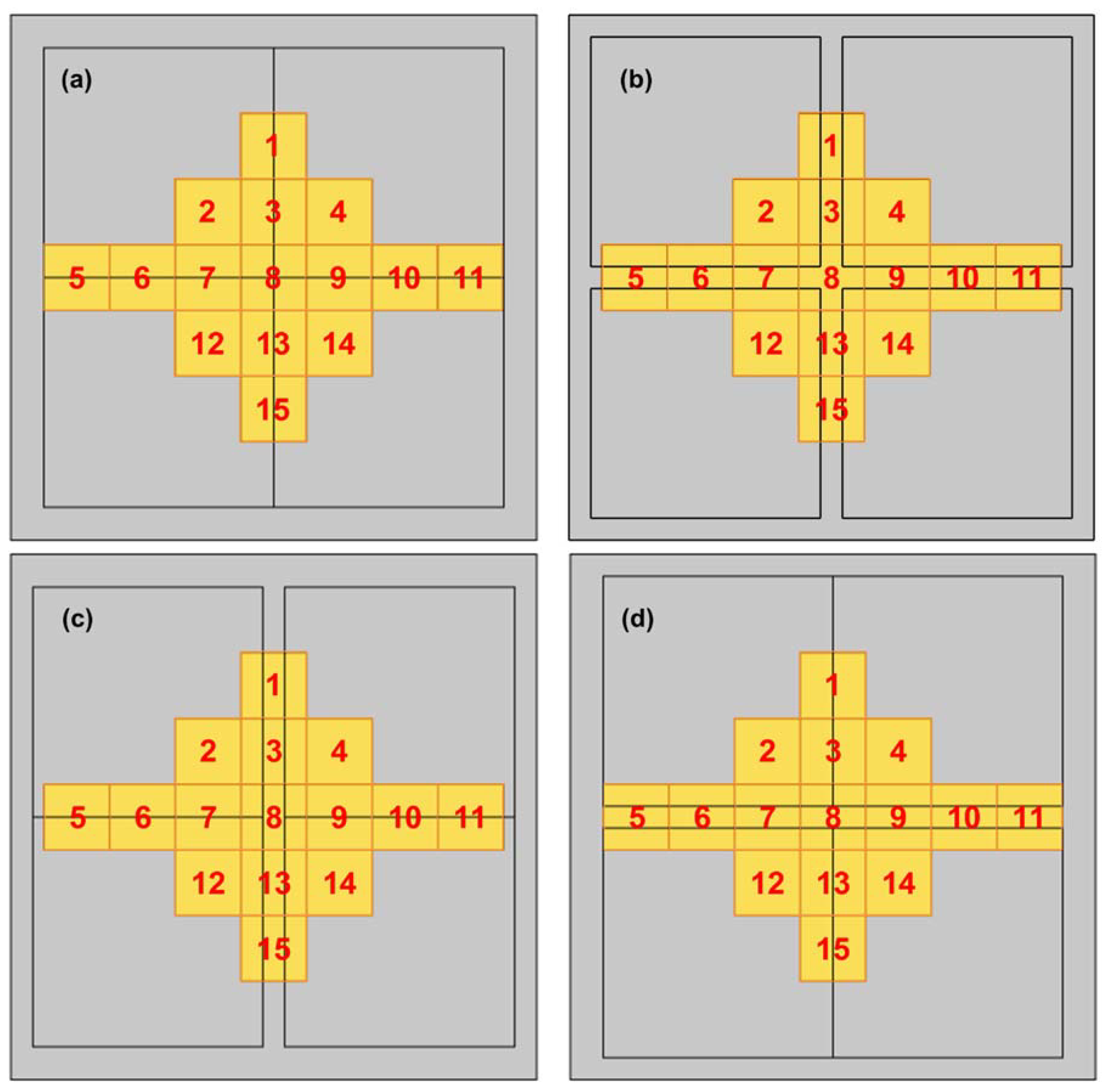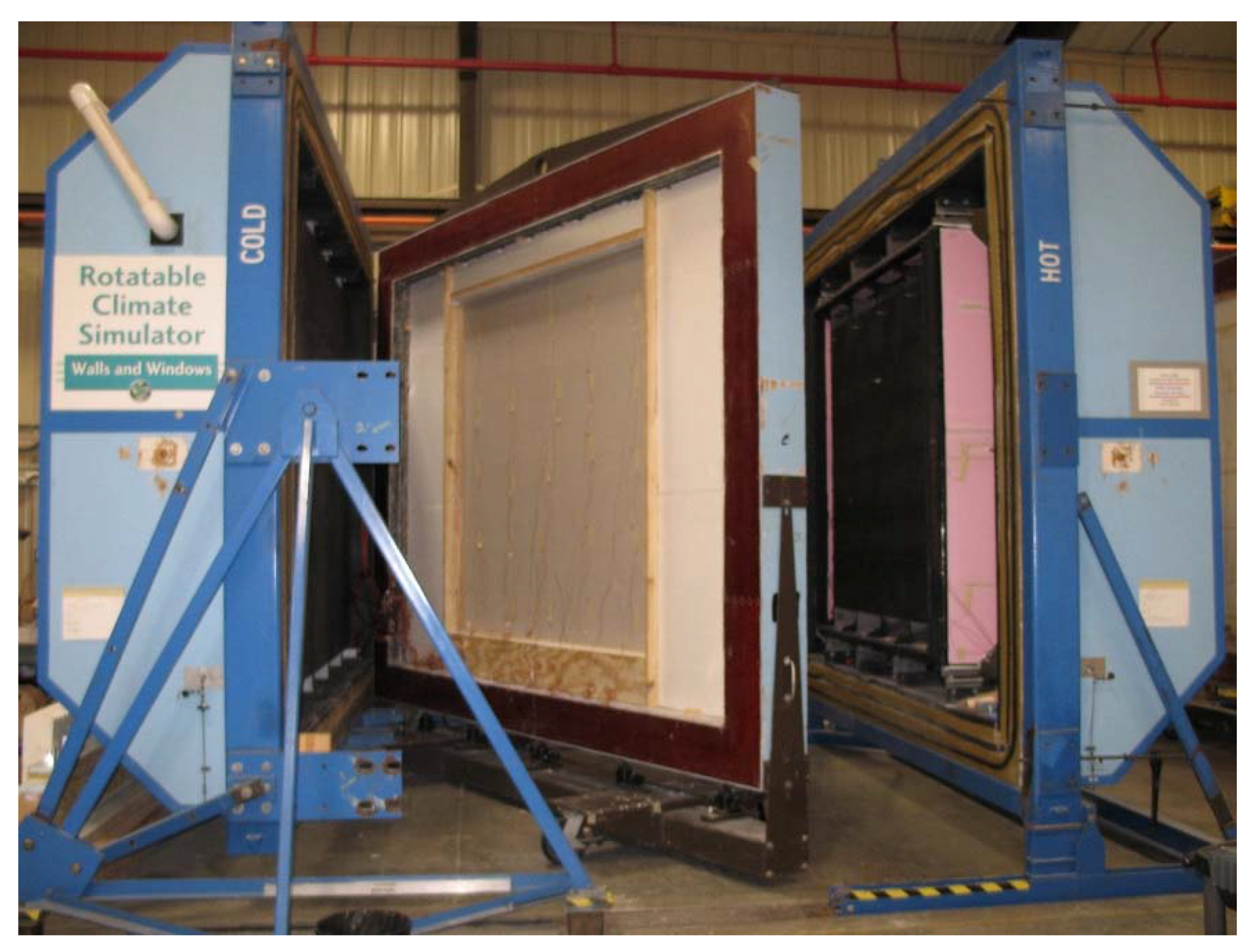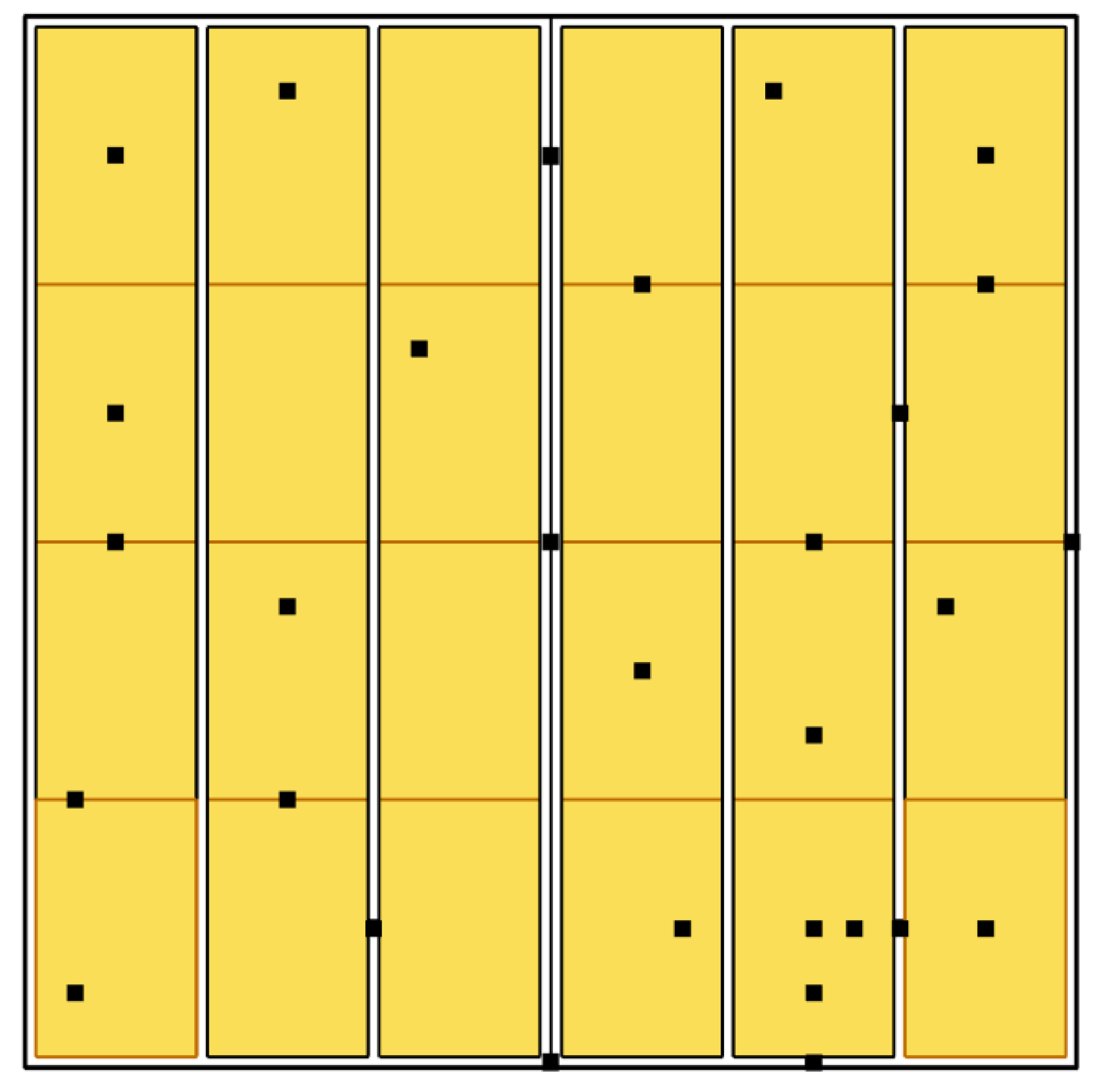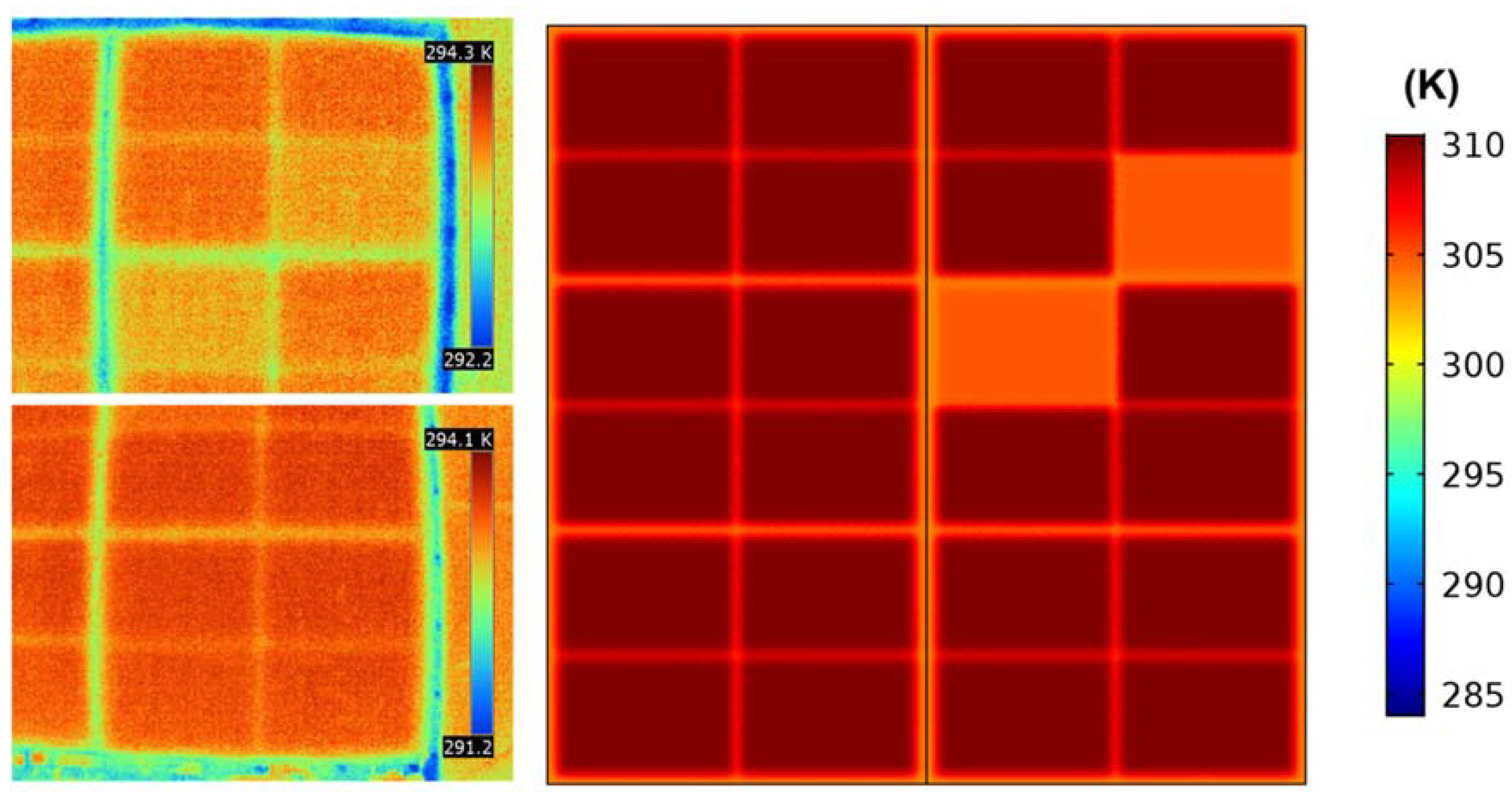1. Introduction
Vacuum insulation panels (VIPs) are considered a more effective alternative to conventional building insulation materials for reducing heat losses through the building fabric and developing energy efficient buildings [
1]. VIPs have been demonstrated in an additively-manufactured, prototype building [
2], building retrofit in a subarctic climate [
3], apartments and office buildings [
4], among others. Yang et al. [
5] described the development of thin, translucent VIPs for use in windows.
VIPs typically contain open-celled, porous materials that are evacuated and sealed within an impermeable envelope or barrier film [
6]. Evacuation of the interior porous structure yields significantly improved thermal performance compared to conventional insulation materials. VIPs can achieve center-of-panel (COP) conductivities of 0.003–0.005 W/m-K compared to 0.02 W/m-K or higher for traditional foam and fibrous insulation materials [
7]. However, when used as part of the building fabric or envelope, the overall or effective thermal conductance of the VIPs need to be considered [
8]. Including edge effects due to the barrier films, which are typically highly conductive, can provide a more realistic effective thermal conductivity of VIPs [
9].
Schiedel et al. [
10] performed finite element analyses of wall systems incorporating VIPs. When using the COP thermal conductivity of VIPs, the theoretical estimate of the wall thermal resistance was higher by 41% than the experimental results. On implementing the effective VIP conductivity based on in-situ experimental data, the theoretical result was within 3% of the measured thermal resistance. Lim et al. [
11] modeled VIPs of different thicknesses incorporated in external walls for building energy performance. The authors utilized different thermal conductances for different VIP thicknesses but did not explicitly describe how the U-values were calculated and if the edge effects of VIPs were considered [
11]. Park et al. [
4] modeled external insulation systems using VIPs to determine their effectiveness in high-performance insulation systems for high-rise apartment buildings. They calculated effective VIP conductivity using a combination of the COP conductivity and a linear thermal transmittance of the barrier film coupled with the VIP dimensions [
4].
Wakili et al. [
9] reported one the earliest works defining the effective VIP thermal conductivity as the COP conductivity augmented by an additional term due to the edge effect. The edge effect was defined in terms of a linear thermal transmittance of the barrier film and the VIP dimensions (area, perimeter and thickness). The linear thermal transmittance was estimated from heat flow measurements through COP of VIPs and joints between VIPs. The authors noted that their definition of effective VIP thermal conductivity was only dependent on the VIP itself and not on the assembly details when the VIPs are incorporated in a building envelope system [
9]. Tenpierik and Cauberg [
8] developed an analytical equation that predicts the effect of the thermal bridge induced by a VIP barrier laminate. Tenpierik et al. [
12] performed a follow-on study to expand the analytical equation of [
8] to evaluate building panels incorporating VIPs, which often contain thick facings and spacers between VIP edges. The authors used series and parallel resistance networks to calculate the effective thermal conductivities of the facings and edge spacers. Choi and Song [
13] defined the edge conductivity of a VIP with an aluminum (Al) foil barrier as a function of the product of the Al foil conductivity and thickness, divided by the width of the VIP.
Wakili et al. [
9] performed numerical simulations of VIPs by resolving the multi-layered barrier films using very fine grids in the vicinity of the high-conductivity films. The only simplification was to consolidate multiple layers of identical materials into one layer of equivalent thickness. The authors found excellent agreement between measured and calculated thermal resistances of two adjacent VIPs [
9]. However, such fully-resolved models are inapplicable for large-scale systems containing VIPs due to the multitude of very thin and highly conductive layers [
14]. Van Den Bossche [
15] also performed simulations while resolving the barrier film, but artificially increased the film thickness so the whole model could be meshed using a single grid size. Simulations were done with combinations of multi-layered films, folded edges and an air gap; the best agreements (10–20%) with experimentally-determined edge transmittance were obtained when all three were considered [
15]. Wakili et al. [
16] also assumed an artificial nominal thickness of the barrier envelope and determined the corresponding thermal conductivity by calibrating simulation results with measurements. The authors noted the strong dependence of the modeled barrier conductivity on the air gaps between VIP joints and materials adjacent to the VIPs [
16].
Sprengard and Holm [
17] simulated VIPs and constructions incorporating VIPs by considering the thermal transmittance of the components, including the elements without thermal bridging (e.g., COP conductivity), linear thermal transmittance (e.g., panel edges) and point thermal transmittance (e.g., mechanical fasteners). Non-uniform meshes were used to resolve the barrier film layers. However, the simulations were limited to VIPs alone and other building components were not modeled, except to simulate the effects of boundary layers and mechanical fasteners. Capozzoli et al. [
18] investigated the effect of thermal bridging in real building applications in which VIPs were coupled to other layers and jointed/fixed to proper frames. Thermal bridging effects due to the VIP edges and structural joints were considered. Linear thermal transmittances of the thermal bridges were obtained from a steady-state numerical model, and by combining with measurements of COP conductivities of VIPs, a suitably modified effective thermal transmittance of the VIPs was assessed [
18]. Kim et al. [
19] numerically studied walls incorporating VIPs; different configurations such as VIPs with and without Al foil barrier as well as VIPs encapsulated within expanded polystyrene (EPS) were investigated. Simulation results of linear thermal transmittance of thermal bridges and effective thermal transmittance of the walls were presented, but the calculation methodology was not explained in detail [
19].
The current work presents finite element analysis (FEA) models of small (0.61 × 0.61 m) and large (1.22 × 2.44 m) composite insulation boards containing VIPs that are completely embedded within foam insulation. The development and experimental evaluations of the composite boards have been described by Biswas et al. [
20]. The foam-VIP composite insulation described in the previous study [
20] is suitable for widespread implementation in buildings. Their production method is similar to existing manufacturing processes. The foam serves to protect the VIPs and the composite is structurally-similar to existing foam insulation boards in terms of handling and installation; thus, the composites can be installed without major changes to construction practices and there is no need to handle individual VIPs at construction sites.
Here, effective edge conductivities of the VIPs at the different interfaces within the composites were estimated by parametric modeling and error-minimization of the differences between the simulation results and experimental data from selected 0.61 × 0.61 m composites. Different edge conductivities were determined based on the material adjacent to the VIPs, i.e., VIP-VIP or foam-VIP interfaces. Impacts of folds were also included by assuming adequate numbers of layers of the barrier films. Next, the estimated edge conductivities were verified by simulations of a separate set of foam-VIP composites and comparing the simulated results of heat flows and thermal resistance with experimental data. Thus, different sets of experimental data were used for estimation and validation of the edge conductivities. Further, the validations were done with experimental measurements of both small- and large-scale samples, with different types of boundary conditions, providing a stringent test of the modeling approach.
This article is organized as follows:
Section 2 and
Section 3 briefly describe the foam-VIP composites and the experimental characterization methods; these have previously been described by Biswas et al. [
20], but are briefly summarized here for ease of understanding;
Section 4 describes the model development, input parameters and boundary conditions; finally,
Section 5 describes the results of the estimation and verification of the effective edge conductivities.
6. Conclusions and Future Work
This article presents detailed development and validation of finite element models of foam-VIP composites to estimate effective edge conductivities of VIPs and their impacts on the overall thermal resistance of the composites. The edge conductivities were estimated by comparing the simulation results with measurements of 0.61 × 0.61 m foam-VIP composites and using an error minimization method. The edge conductivities were estimated by taking into account the neighboring materials, i.e., whether the VIPs were adjacent to other VIPs or foam insulation. Models incorporating the edge conductivities were then used to simulate additional 0.61 × 0.61 m and 2.44 × 1.22 m composites. The simulations used either the same boundary conditions as the experiments or used the experimental parameters to define the appropriate boundary conditions. The model predicted thermal resistance of a large-scale composite with all intact VIPs was within 4.7% of the measured value.
Overall, the simulation results were in good agreement with the experimental results, verifying the efficacy of the modeling approach presented here. Thus, using measurements of a limited number of small-scale foam-VIP composites from heat flow meter tests or similar, appropriate thermal transmission properties of embedded VIPs can be obtained. Those thermal transmission properties can then be utilized for modeling full-scale foam-VIP composites for building applications and generate useful energy saving estimates.
The proposed modeling approach has broad applicability to VIP-based systems and composites. However, accurate knowledge of the thermal transmission properties of the different interfaces are required. The proposed method shows that simulations combined with measurements from small-scale samples, which are suitable for heat flow meters, are adequate to estimate the overall thermal resistance or conductance of full-scale systems containing VIPs; the advantage is that heat flow meters are quite commonly used by the industry and research organizations.


















